
L’Arroseu
Comics and cartoons are first cousins. Developed more or less at the same time, they present a specular kinship not entirely free of animosity, in the manner of those eternal teenagers who kick each other under the table. But the Cinema, that respectable figure watching over the boys, is not much older and actually owes them more than he’d like to admit. After all, the first film with a fictional plot, the short “L’Arroseur arrosé”, by Louis and Auguste Lumière (1895), was nothing more than a comic page adaptation, and the whole cinema’s very act owes a lot to the “Théâtre Optique” of Émile Reynaud, creator of cartoons that predates any cinematographic work.
The paper-to-screen passage went in both directions and is too well known for us: from Little Nemo to Mickey Mouse, the revolving door between the two languages has not ceased to turn, creating a sense of natural continuity that is nothing but an illusion. To denote to the artificiality of this conception, it is best to dwell on some of the weirdest comic adaptations ever produced, which seem to tell us that there is more than one way to skin (or animate) a cat. They are not cartoons strictu sensu: no drawings are harmed. But neither are they just a bare recording of regular actors playing for the camera. We snobs like to call them “living cartoons”.
“Fortunello”, by Ettore Petrolini
Frederick Burr Opper (1857-1937) was one of the pioneers of American newspaper comic strips. His comic characters were featured in magazine gag cartoons, covers, political cartoons and comic strips for six decades, but perhaps his best remembered work is a comic strip about a funny hobo named Happy Hooligan, which appeared in print around 1900.
BELOW: Happy Hooligan film adaptation with actors in 1903.
BELOW: Happy Hooligan animated cartoon adaptation (1917).
Like the later Mutt and Jeff, Krazy Kat or George McManus’ regular cast, Happy Hooligan got a classic animated cartoon adaptation, being at the same time one of the first (if not the first) American comic strips to be known worldwide.
In Italy it was called Fortunello, and there it was read by the great comedian Ettore Petrolini (1884-1936), who adapted it for one of his stage acts around 1915.

Ettore Petrolini.
His Fortunello took the comic looks of Opper’s character, endowed with a personality closer to the taste of the futurists, who adopted the guy as a mascot of the whole movement. In any case, Petrolini’s Fortunello was more like a robot than a hobo, a representative of the future, the first pop hero to manifest himself as such. And he invented rap in passing.
Here, a film reconstruction of the act made by Petrolini in 1935 for his film “Nerone” (directed by Alessandro Blasetti). Note the particular emphasis on the “grotesque”, which was probably the most striking aspect of the new graphic language, before being replaced by something called “appeal”.
“Pancho Talero”, by Arturo Lanteri.
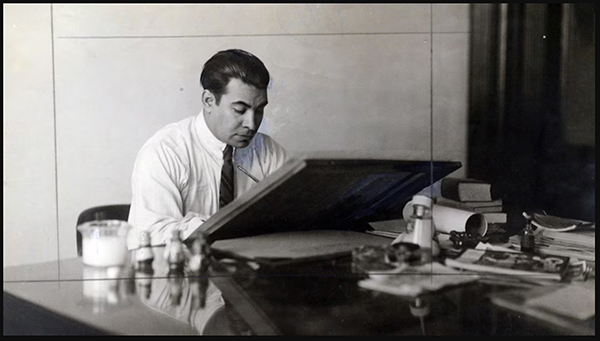
Arturo Lanteri
Arturo Lanteri (1891-1975) was the first Argentine cartoonist who can be said to have managed to turn his creations into a brand, an achievement perhaps shared with Diógenes Taborda (already mentioned in these columns). Lanteri’s star shone until it was somewhat eclipsed by the unstoppable Dante Quinterno -who, by some chance, had been assistant to both Lanteri and Taborda. His most popular creation was called “Las aventuras de Pancho Talero”, a family strip drawn in the tradition of George McManus’ “Bringing up Father”.
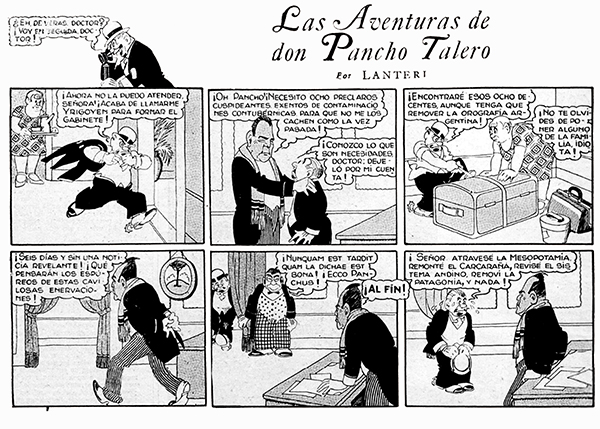
Pancho Talero’s comic strip.
Talero’s bunch had more pretensions than resources and tried to cope with the high classes -with uneven luck- under the iron rule of Mrs. Talero. The popularity of Lanteri’s creatures generated at the time a huge amount of merchandising and even three live action features, written and directed by Lanteri himself: “The Adventures of Pancho Talero” (1929), “Pancho Talero in the Stone Age” (1930) and “Pancho Talero in Hollywood” (1931).
Pancho Talero also got his own tango. Here’s the piece, illustrated with Lanteri’s production:
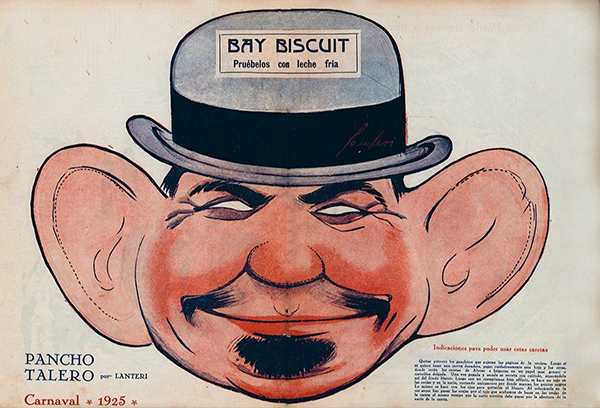
A Pancho Talero mask
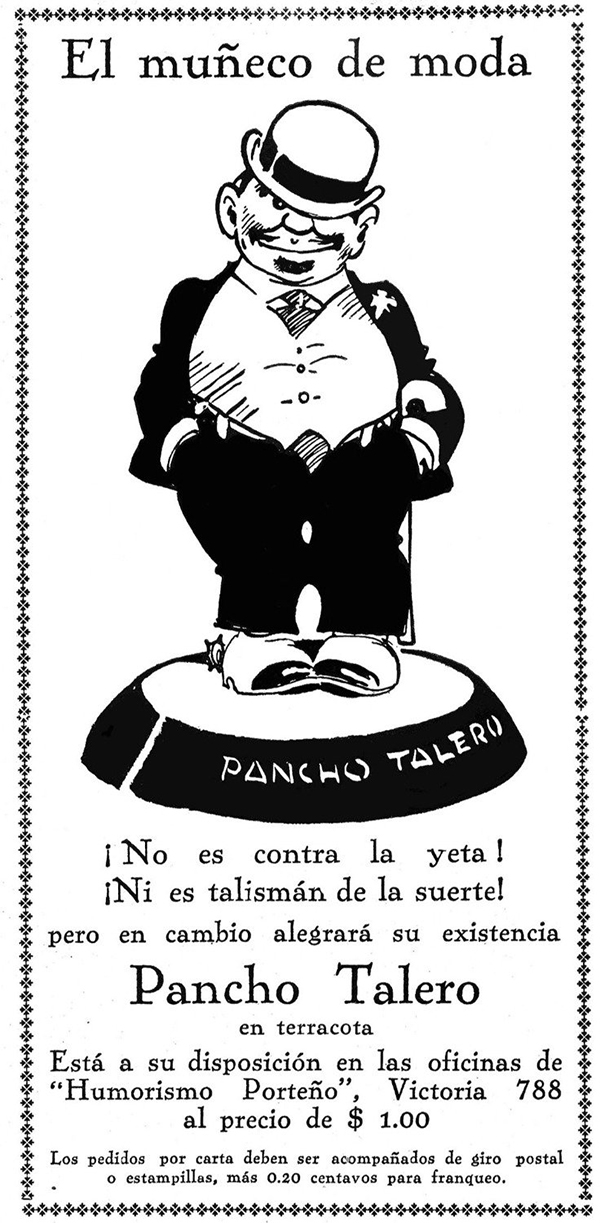
Pancho Talero’s merchandising.
Since, as customary in Argentina, Lanteri’s films were lost, for a long time they were considered an extravagance designed to squeeze the popularity of the characters (all that was known about them was that “Pancho Talero in Hollywood” was a parody of Douglas Fairbanks’ “The Gaucho”, with a soundtrack added at the last minute).
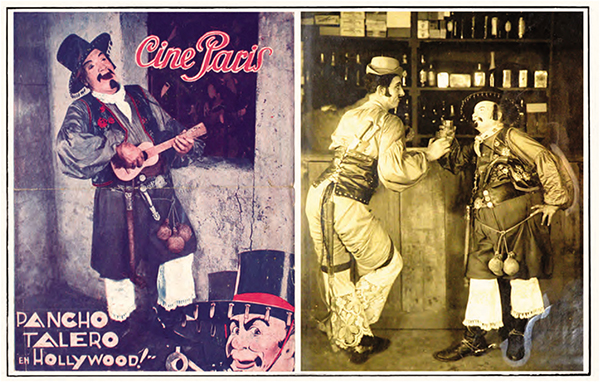
Pancho Talero’s Fairbanks spoof.
However, a couple of decades ago, a ten-minute fragment of the second of these productions appeared in some vault. What remains of “Pancho Talero in the Stone Age” (“Pancho Talero en la prehistoria”) has something of Chaplin’s or Keaton’s incursions into the genre but it also shows that Lanteri was an excellent director, within a genre (as far as I know) absolutely unexplored in Argentine film production: the slapstick comedy. In any case, the discovery made doubly regret the loss of the rest of Lanteri’s film production.

One of Lanteri’s movie versions of Pancho Talero.
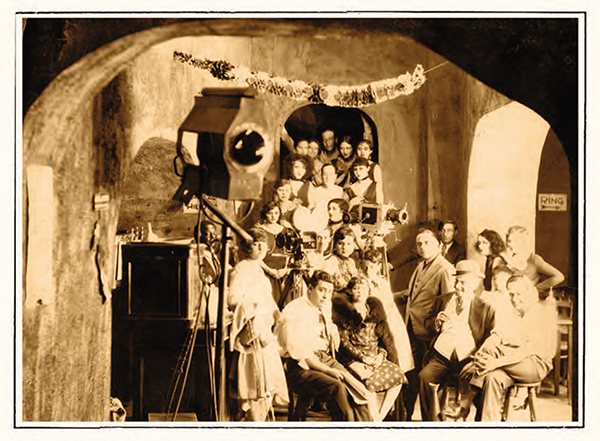
The crew of Lanteri’s cinematographic productions.
In the technical field of how to adapt to the screen a drawn character, Lanteri proposes a very simple device: Pepito Petray (as mr. Talero) wears a rigid mask with the character’s features printed on it. It works smoothly, against all odds.
Lanteri’s film (above)starts at 4’20’’, and the entrance of its title character happens at 10’30’’. For the Spanish speakers, Mr. Peña, our host, offers interesting additional details.
Of course, this brief detail does not imply that there are no weirder comic adaptations lurking just around the corner. We had better be cautious with our printed friends.


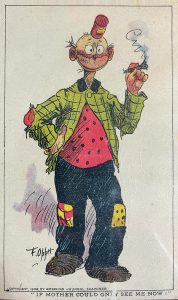
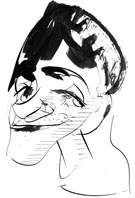 Lucas Nine is an Argentine artist: illustrator, graphic novel author, animator and director of animated films. His work has been awarded several times and published, exhibited and screened in Argentina, Brasil, Mexico, Canada, Spain, Italy, France, Germany, Hungary, Netherlands and Japan. Check out his animation and artwork online:
Lucas Nine is an Argentine artist: illustrator, graphic novel author, animator and director of animated films. His work has been awarded several times and published, exhibited and screened in Argentina, Brasil, Mexico, Canada, Spain, Italy, France, Germany, Hungary, Netherlands and Japan. Check out his animation and artwork online: 









































I’ve seen “L’Arroseur arrosé”, but I had no idea the scenario was derived from a German cartoon! “Ein Bubenstreich” means “A boy’s prank”, and cartoons about young pranksters were immensely popular in Germany during the late 19th and early 20th centuries; my grandfather had several books full of them. The genre goes back at least as far as the medieval folktales of Till Eulenspiegel but really took off in the mid-1800s with the illustrated poems of Wilhelm Busch, especially “Max und Moritz”; these were seminal in the development of the comic strip, the comic book and, by extension, the animated cartoon. Years ago I saw a bizarre animated adaptation of “Max und Moritz” made in Germany in the 1970s. It was explicitly pornographic, and the boys’ “lustige Streiche” (merry pranks) involved the schoolmaster’s wife and the police constable’s daughter.
In the U.S. sitcom “Leave It To Beaver”, patriarch Ward Cleaver mentions Happy Hooligan in at least three different episodes and was apparently quite a fan of the comic strip in his youth. That would have been where I first heard of the character. “Leave It To Beaver”, incidentally, is also where I first learned a complete sentence in Spanish. It was “Usted tiene una cara como puerco.”
Ettore Petrolini’s Fortunello costume reminds me of an episode of “The Outer Limits” that scared the crap out of me when I first saw it around age twelve, while the Pancho Talero excerpt reminds me of Ringo Starr and Shelley Long in “Caveman”, a Stone Age slapstick comedy made 50 years later. I hope more of Lanteri’s film work surfaces someday.
In fact, there were several comics pages around this idea: I do remember one in the Bristish Punch, another example in the French press, etc. It was the running gag from the XIX century. But the kinetic Max und Moritz are indeed a couple of comic precursors (most clearly in their Katzenjammer reincarnation, with German accent included).
Jules Feiffer capped his caricatures of Gerald Ford with a tin can hat, referencing the long-ago Happy Hooligan (See the book “Jules Feiffer’s America”). Wondering how many people caught it at that late date.
“Pancho Talero” looks like a slightly thinner version of “Charlie Chan! – at least to me!
The ad slogan on the Pancho Talero mask (perhaps a giveaway offer) I was able to translate, thanks to Google Translate, as “Try them with cold milk.”
The Bay Biscuit were in the market for a long time. It seems Pancho sold some advertising space in his hat.
In the list of bizarre adaptations, I think that the adaptation of Louis Forton’s comic strip “Les Pieds nickelés” by animation pioneer Émile Cohl in 1917 should be high on the list, especially as, for all the strangeness of the animation, the gags are extremely ahead of their time, some even anticipating those of Tex Avery.
See for yourself: https://www.youtube.com/watch?v=bBNhmzkDShA&pp=ygU2TGVzIGF2ZW50dXJlcyBkZXMgUGllZHMgTmlja2VsZcyBcyAow4ltaWxlIENvaGwsIDE5MTgp
Émile Cohl also adapted a comic strip created by the famous illustrator Benjamin Rabier, this animated series has unfortunately been lost; publicity images can be found on this site:
https://criminocorpus.org/en/expositions/anciennes/art-et-justice/rene-navarre/les-dessins-animes-de-benjamin-rabier/
Cohl was dubbed the “inventor” of cartoons, in the sense that he was the first to use frame-by-frame in film to photograph pure animated drawings (i.e., neither stop motion nor effects combined with actors). I didn’t know his adpatation of “Les Pieds”. It’s a jewel of inventiveness, thank you very much. He also animated McManus characters (The Newlyweds) in the USA.
Some fragments of the films he made with Rabier are preserved, but they are very difficult to find. Thanks again.